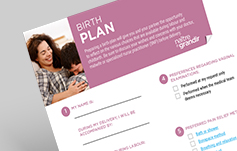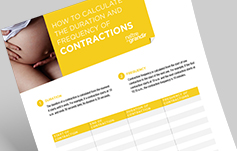Advice to help parents have a positive birthing experience.
Below is a list of tips to help expectant parents have a positive experience during labour and delivery. This fact sheet focuses on the three phases of stage 1 (latent, active, and transition) and stage 2. For more information about each stage, read our fact sheet on the four stages of labour and delivery (link in French).
Stage 1: The latent phase
This is the first phase of stage 1. It begins when contractions become more regular and ends when the cervix is 3 cm dilated. These initial contractions are generally mild.
Tips for the mother
-
Finish packing your overnight bags, make any necessary phone calls, etc.
-
If you go into labour at night and don’t feel much discomfort, try to sleep or rest before your contractions intensify. If labour begins during the day, try to rest between contractions.
-
To keep up your energy, eat small snacks that are easy to digest.
- Drink fluids (water, fruit juice, popsicles, etc.) at regular intervals.
- Walk to reduce your discomfort, stimulate labour, and take your mind off the painful contractions.
Do you have a birth plan? A birth plan lets you indicate your preferences for labour and delivery.

-
To ease the pain, you can also take a warm shower or bath, get a massage, rock back and forth, or practise rhythmic breathing.
Tips for the partner
- Stay with your partner while she’s in labour.
-
If she wants to walk around, go with her.
- Encourage her to change positions.
-
Play a board game or watch TV together to distract her from the pain.
-
Use a variety of methods to increase her comfort and reassure her (comforting touch, massage, rhythmic breathing, encouraging words, etc.).
- Apply a cold or warm compress to her face or forehead, whichever she prefers.
- Offer her easily digestible food and drinks or ice chips.
-
Help her apply lip balm.
-
Help her take a warm shower or bath.
- Remind her to urinate often.
-
Take note of the duration and frequency of the contractions.
Stage 1: The active phase
During the second phase of stage 1, the cervix dilates from 3 cm to 7 cm. The contractions become longer, more frequent, and more painful.
Tips for the mother
- Change position regularly to reduce discomfort and help labour progress.
-
Try to hold the same position for at least two contractions to give yourself time to adjust. If you’re still uncomfortable, try another position.
Our downloadable guide will help you calculate the duration and frequency of your contractions.

- Choose positions that accentuate the effect of gravity to help the baby move down the birth canal:
– Stand while leaning against your partner, sit down, lean forward while holding on to a chair, or kneel on all fours.
– Squat or sit on a toilet seat to open up your pelvis.
– Lying on your back is not recommended during labour, but if you find it comfortable, place a pillow under your right hip to clear the inferior vena cava and allow better blood flow to the baby.
- Urinate often to empty your bladder.
- Drink small amounts.
- Get a massage or have heat or cold applied to painful areas.
-
Find a good breathing rhythm.
- Rest between contractions. Visualize your baby.
- Take a warm bath or shower to help you cope with the pain and relax. When the baby’s head is engaged and the membranes are ruptured, it may be possible to take a therapeutic bath. The hospital staff will explain the procedure to you.
Tips for the partner
-
Continue to support your partner. Stay nearby and listen to her needs.
- Encourage her and praise her for managing her pain so well.
- Reassure her with comforting words and slow, gentle gestures. Give her massages.
- Help her change positions, stand up, or walk around to help the baby move into the birth canal.
- Help her find a breathing rhythm.
- Provide her with hot or cold compresses, whichever she prefers.
- Bring her ice chips, drinks, and food if the situation permits.
- Help her take a warm bath or shower.
- Remind her to urinate often.
- Avoid criticizing or upsetting her.
- Don’t take her words or behaviour personally. During labour, she may act differently or be irritable. This is perfectly normal.
-
Don’t overexert yourself, and rest whenever you have the chance.
-
Don’t forget to eat.
Stage 1: The transition phase
During the final phase of stage 1, the cervix dilates to 10 cm, which is the diameter needed for the baby’s head to pass through the birth canal. This is the shortest but most difficult phase.
Tips for the mother
- Get into comfortable positions and find a good breathing rhythm.
-
Try to focus on one contraction at a time.
-
Try to close your eyes and breathe regularly between contractions.
Tips for the partner
During this stressful phase, your partner will need you to help her focus. Here’s how you can help:
-
If she doesn’t feel like talking, ask her to look at you. You can rely on her non-verbal signals to determine her needs.
- Offer encouragement.
-
If she’s cold, help her put on socks or wrap her in a blanket.
- Remind her to breathe rhythmically. To keep her breathing steady, you can follow the same breathing pattern (e.g., hee hee, hoo hoo).
- Communicate her preferences to the care team, if necessary.
Stage 2: Delivery
This stage begins when the cervix is fully dilated (open). It ends when the baby is born.
Depending on your situation, your preferences, and the recommendations of your care team, you may decide to start pushing as soon as you feel the urge or instead wait for the contractions to bring the baby down into the pelvis to limit active pushing.
If you’ve had an epidural, you may not feel the need to push. It’s okay to wait until you feel a strong urge to do so. This technique, called spontaneous pushing, allows the baby to descend more naturally. Studies have shown that spontaneous pushing has the following benefits: -
Delivery is more efficient and the mother is less tired
-
The mother is less likely to need a vacuum- or forceps-assisted birth
-
There is less risk of tearing in the perineum
-
The baby receives more oxygen, leading to less fetal distress
|
Tips for the mother
Notify your doctor or midwife when you feel the urge to push. If you don’t feel an urge, your care team will let you know you when it’s time to start pushing.
An effective push provides maximum oxygen to both the mother and baby and allows the perineum to stretch gradually.
Here are a few tips for effective pushing:
-
Depending on your position, listen to the advice of your nurse or midwife.
- Relax the pelvic floor muscles (perineum).
-
Unless you are told that the baby needs to come out quickly, push the baby down gradually, giving 3–5 small pushes with each contraction. This method gives your vaginal tissue time to stretch and reduces the risk of tears. It’s also less demanding on the baby.
-
Focus on pushing your baby down. Imagine you’re giving them as much space as possible. Visualization can help encourage your baby’s smooth descent.
- Try not to hold your breath during a push. You shouldn’t stop breathing for more than five seconds. When you push, exhale slowly, as if you’re slowly emptying a balloon of air. This technique has less harmful effects on the perineum.
-
Often, it can be helpful to grunt after each push. Grunting is an effective method because it lowers the diaphragm, which then exerts pressure on the uterus. This type of natural vocalization should be encouraged, unlike shouting, which expends energy and prevents you from pushing.
- Your care team will update you on your baby’s descent as you push.
- Between contractions, let them know how you’re feeling. They’ll also keep you informed and ensure that any interventions are adapted to your needs.
- Rest and relax between contractions.
Tips for the partner
-
You may need to help your partner find a comfortable position for pushing. Support her if necessary.
- Offer encouragement and let her know how the delivery is going. For example: “His head is almost out!”
-
At this stage, your partner needs simple and clear instructions from one person. Make sure she feels guided and reassured.
- Keep her comfortable between contractions by placing a pillow between her legs, giving her water, etc.
- Make her preferences known if necessary.
Things to keep in mind
-
Rest between contractions.
-
Change positions to relieve the pain and coax the baby down.
-
Follow the care team’s instructions when it’s time to push.
| Scientific review: Roxanne Piché, nursing adviser, Maternal Fetal Medicine Clinic, CHU Sainte-Justine
Research and copywriting:The Naître et grandir team
Updated: September 2020
|
Sources
Please note that hyperlinks to other websites are not updated regularly, and some may have changed since publication. If a link is no longer valid, use search engines to find the information you’re looking for.
-
Brancato, Robyn M., et al. “A meta-analysis of passive descent versus immediate pushing in nulliparous women with epidural analgesia in the second stage of labor.” Journal of Obstetric, Gynecologic, & Neonatal Nursing, vol. 37, no. 1, 2008, pp. 4–12.
-
Ladewig, Patricia, et al. Contemporary Maternal-Newborn Nursing Care. Upper Saddle River, Prentice Hall, 2010.
-
Lee, Lily, et al. “Management of spontaneous labour at term in healthy women.” Journal of Obstetrics and Gynaecology Canada, vol. 38, no. 9, 2016, pp. 843–865.
-
Lowdermilk, Deitra Leonard, et al. Maternity and Women’s Health Care. Mosby, St. Louis, 2012.
|